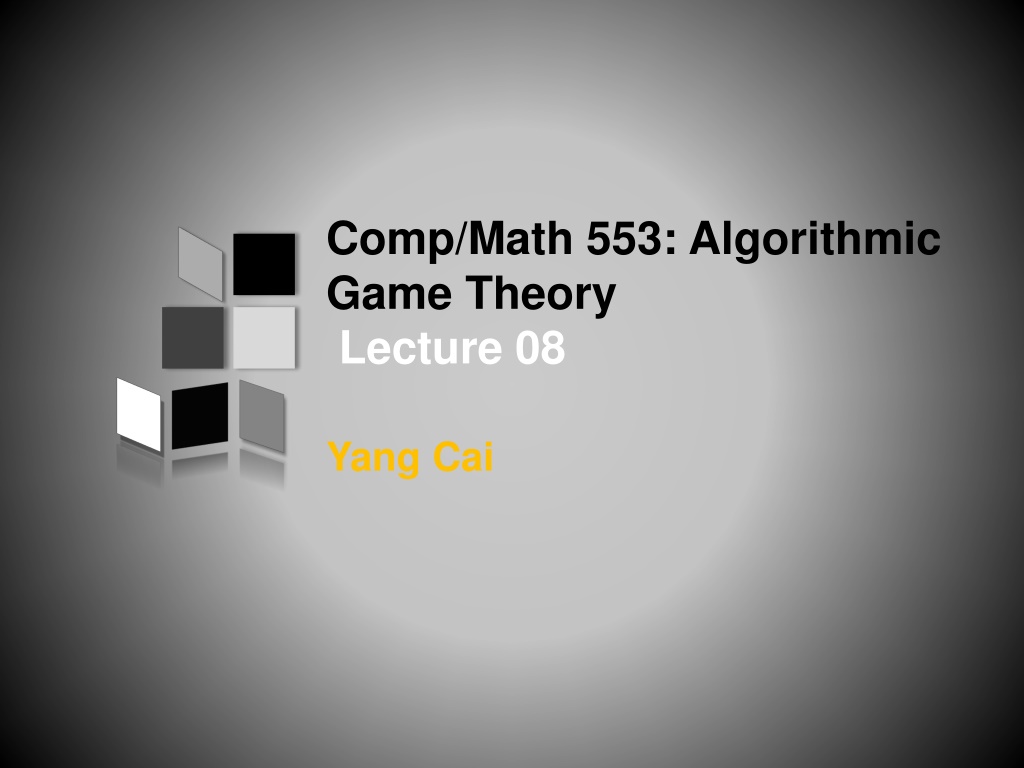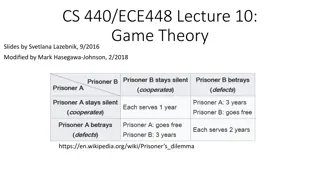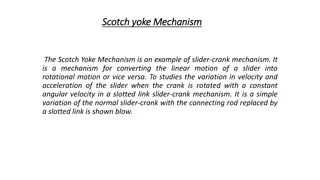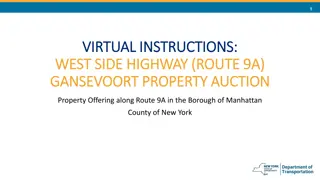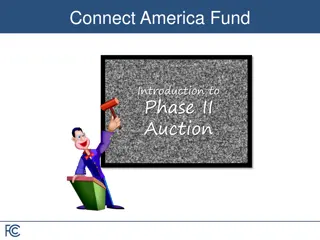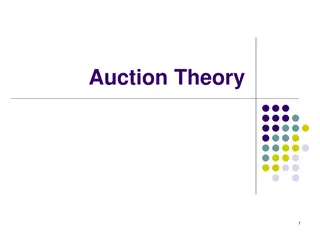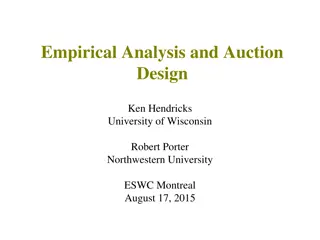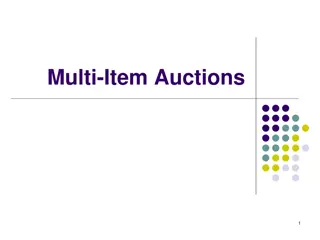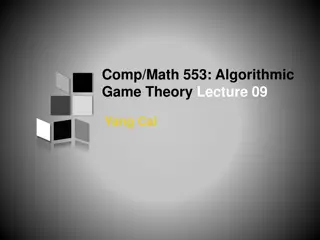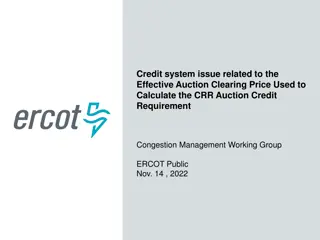Mechanism Design and Auction Theory in Game Economics
Today's lecture covers the concepts of mechanism design and single-item auctions in the field of algorithmic game theory. Mechanism design focuses on reverse-engineering existing game systems to achieve desired objectives, while auctions play a crucial role in various scenarios such as online marketplaces, sponsored search, and spectrum allocation. The discussion delves into sealed-bid auctions, welfare maximization, and bidding strategies for maximizing social welfare in auction environments.
Download Presentation

Please find below an Image/Link to download the presentation.
The content on the website is provided AS IS for your information and personal use only. It may not be sold, licensed, or shared on other websites without obtaining consent from the author. Download presentation by click this link. If you encounter any issues during the download, it is possible that the publisher has removed the file from their server.
E N D
Presentation Transcript
Comp/Math 553: Algorithmic Game Theory Lecture 08 Yang Cai
Todays Menu Mechanism Design Single-Item Auctions Vickrey Auction
Most of Game Theory/Economics devoted to Mechanism Design Understanding an existing game/economic system. The Engineering side of Game Theory/Economics Explain/predict the outcome. Existing System Mechanism Design reverse the direction Outcome Predict Identifies the desired objective first! Asks whether it is achievable Goal Achievable? And, if so, how? System Mechanism Design
Auctions Mechanism Design Auctions Auctions Elections, fair division, etc.
Single-item Auctions: the setup Bidders Auctioneer v1 Item 1 vi i n vn Bidders: have values on the item. These values are Private. Quasilinear utility: vi pi,if wins. -pi,if loses.
Auction Format: Sealed-Bid Auctions Bidders Item v1 1 Auctionee r vi i n vn Sealed-Bid Auctions: 1. Each bidder i privately communicates a bid bi to the auctioneer e.g. in a sealed envelope. allocation rule x: Rn [0,1]n 2. The auctioneer decides who gets the good (if anyone). price rule p: Rn Rn 3. The auctioneer decides on prices charged.
Auction Objective: Welfare Maximization Bidders Item v1 1 Auctioneer vi i n vn Def: A sealed-bid auction with allocation rule x and price rule p derives welfare: focus of this lecture: welfare maximization bidding strategies of bidders based on information they have about each other s values (if any), x, p
Auction Format: Allocation and Price rules Bidders Item v1 1 Auctioneer vi i n Natural Choice: give item to highest bidder, i.e. vn Sealed-Bid Auctions: 1. Each bidder i privately communicates a bid bi to the auctioneer e.g. in a sealed envelope. allocation rule x: Rn [0,1]n 2. The auctioneer decides who gets the good (if anyone). price rule p: Rn Rn 3. The auctioneer decides on prices charged. price rule
Auction Format: Selecting the Price Rule Idea 1: Charge no one Each bidder will report + Fails miserably
Auction Format: Selecting the Price Rule Idea 2: Winner pays her bid (first-price auction) Hard to reason about. What did you guys bid? Incomplete Information Setting
First Price Auction Analysis 2 players. Everyone s value vi is sampled from U[0,1]. Bidder i s perspective: bi vi, otherwise even if I win I make negative utility should discount my value, but by how much? it depends on how much other bidders decide to discount their values let me try this first: assume my opponent uses bj= vj under this assumption what is my optimal strategy? expected[utility from bidding bi] = (vi-bi) Pr[bj bi] optimal bi= vi !!! example of a Bayesian Nash Equilibrium I.e. everyone discounting their value by is an equilibrium!
[Games of Incomplete Information Def: A game with (independent private values and strict) incomplete information and players 1, , n is specified by the following ingredients: (i) A set of actions Xi for each player i. (ii) A set of types Ti, for each player i. An element ti Ti is the private information of player i Sometimes also have a distribution Fi over Ti (Bayesian Setting) (iii) For each player i, a utility function ui(ti, x1, , xn) is the utility of player i, if his type is ti and the players use actions x1, , xn
Strategy and Equilibrium Def: A (pure) strategy of a player i is a function Def: Equilibrium (ex-post Nash and dominant strategy) A profile of strategies is an ex-post Nash equilibrium if for all i, all , and all we have that A profile of strategies is a dominant strategy equilibrium if for all i, all , and all we have that
Bayesian Nash Equilibrium Def: In the Bayesian setting, a profile of strategies is a Bayesian Nash equilibrium if for all i, ti and all we have that: ]
First Price Auction Idea 2: Winner pays her bid (first-price auction) For two U[0,1] bidders,each bidding half of her value is a Bayesian Nash equilibrium How about three U[0,1] bidders? or n bidders? Discounting a factor of 1/n is a Nash eq.
First Price Auction Idea 2: Winner pays her bid (first-price auction) What if the values are not drawn from U[0,1], but from some arbitrary distribution F? bi(v) = E[maxj ivj|vj v for all j i] What if different bidders have their values drawn from different distributions? Eq. strategies could get really complicated
First Price Auction Example [Kaplan and Zamir 11]: Bidder 1 s value is drawn from U[0,5], bidder 2 s value is drawn from U[6,7].
First Price Auction Example [Kaplan and Zamir 11]: Bidder 1 s value is drawn from U[0,5], bidder 2 s value is drawn from U[6,7]. o Bayesian Nash eq. : bidder 1 bids his value if it lies in [0,3], otherwise for all b in (3, 13/3], if bidder i {1,2} bids b, then her value is:
First Price Auction (Summary) First Price Auction: Optimal bidding depends on the number of bidders, bidders information about each other Optimal bidding strategy easily gets complicated Nash eq. might not be reached. Winner might not value the item the most.
Second Price/Vickrey Auction Another idea: Charge the winner the second highest bid! maybe a bit strange But essentially used by Sotheby s (modulo reserve price).
Second-Price/Vickrey Auction Lemma 1: In a second-price auction, every bidder has a dominant strategy: set her bid bi equal to her private value vi. That is, this strategy maximizes the utility of bidder i, no matter what the other bidders bid. Hence trivial to participate in. (unlike first price auction) Proof: See the board.
Second-Price/Vickrey Auction Lemma 2: In a second-price auction, every truthful bidder is guaranteed non-negative utility. Sometimes called Individual Rationality Proof: See the board.
Second Price/Vickrey Auction [Vickrey 61 ] The Vickrey auction satisfies the following: (1)[strong incentive guarantees] It is dominant-strategy incentive- compatible (DSIC) and IR (2) [strong performance guarantees] If bidders report truthfully, then the auction maximizes the social welfare ivixi, where xi is 1 if i wins and 0 if i loses. (3) [computational efficiency] The auction can be implemented in polynomial (linear) time.
Second Price/Vickrey Auction Questions: What s so special about 2nd price? How about charging the highest bidder the 3rd price?
Whats next? These three properties are criteria for a good auction. Our goal in future lectures will be to: Tackle more complex allocation problems Tackle more complex objectives, such as revenue
